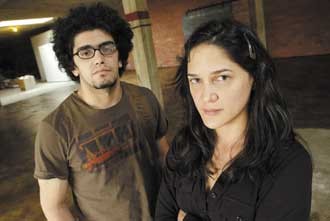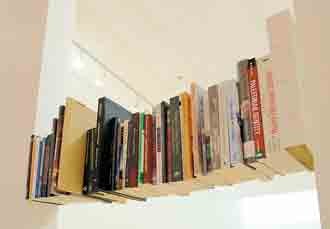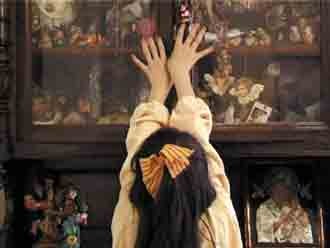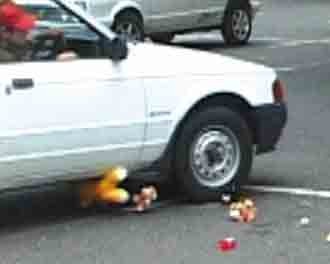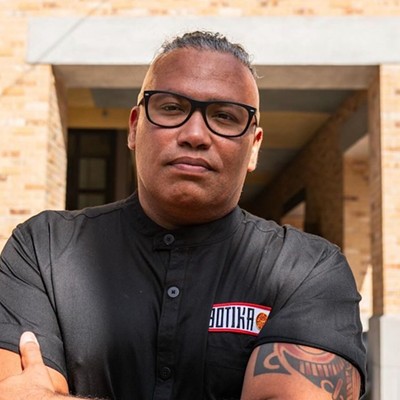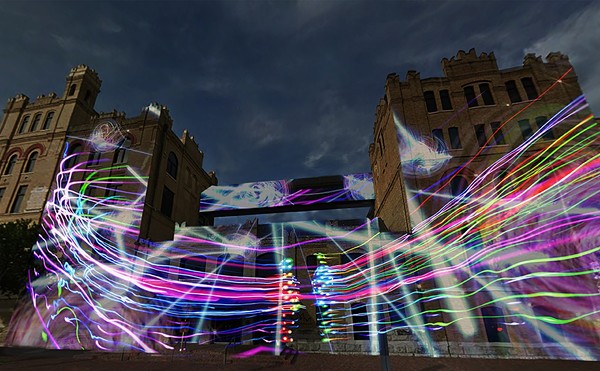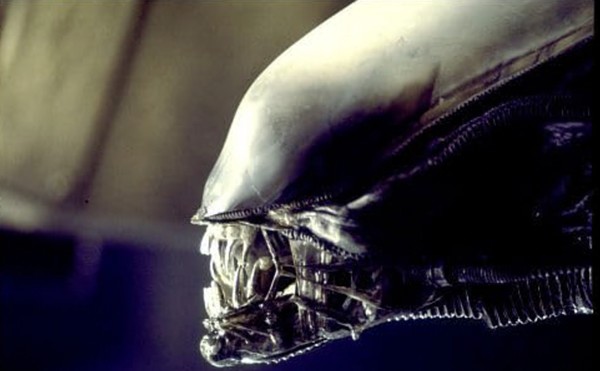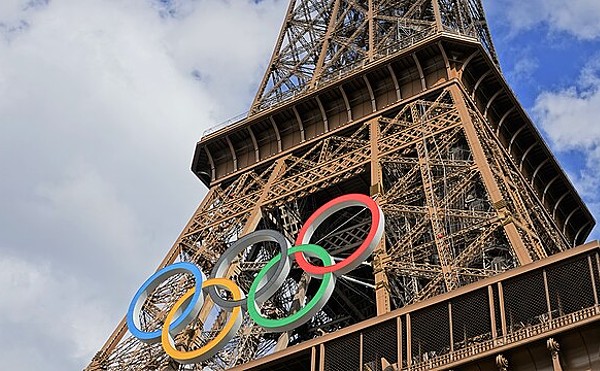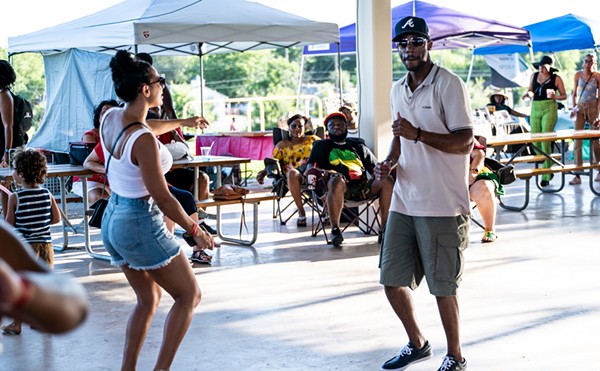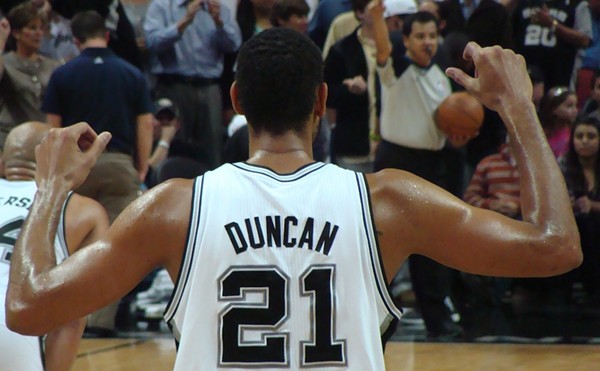Triangle Project Space relocates with Threat Zone
“The triangle has been squared,” sounds like spy code from a Cold War-era movie. That we even think that way, imagining potential danger and intrigue around every corner, is the subject of Threat Zone, the ribbon-cutting show in Triangle Project Space’s new digs, south and west of Southtown.
| Triangle Project Space director Luz Maria Sanchez (right) and curator and artist Basim Magdy. (Photo by Mark Greenberg) |
But the Triangle, named for its original location in a triangular building at the five-points intersection of South Flores, Cevallos, and Nogalitos, really has become a trapezoid, a bracing 2,500-square-foot box of cement bookended by the other portions of Director Luz Maria Sanchez’ life. Living quarters for Sanchez and husband Peter Glassford lie beyond the gallery’s west wall, and movable drywall panels opposite conceal a storeroom and offices for Glassford’s furniture-design business, Tables and More.
Triangle Project Space opened its first set of doors in 2003, and it became known almost immediately for the city’s most contemporary contemporary art — video and sound installations and mixed-media sculpture by international artists — and for the ever-evolving living space. Like the Triangle’s new home, the original TPS was a former commercial space, stripped down to brick walls and cement floors, when Sanchez and Glassford moved in. With each new art show, the space was reconfigured, becoming more like a home and less like an art space, with a cubicle bedroom and a raised platform kitchen overlooking a portable living area that sailed about the room as needed.
| Among the works that appear in Threat Zone include an untitled sculptural installation by Emily Jacir and Anton Sinkewich. |
The makeover was such a success that, last fall, Sanchez and Glassford sold the building to Southtown Realtor Julie Hooper and began to look for a space large enough to accommodate the gallery, an apartment, and Glassford’s growing business. The building they bought, a former wholesale paper distribution warehouse at the corner of LaChappelle and Ellis Bean, is a mid-century industrial structure whose clean, massive aesthetic compliments TPS even better than the turn-of-the-century Flores Street building. The ribs of the poured concrete ceiling are textured with thick grooves, and large skylights (there are the triangles!) made of frosted glass embedded with chicken wire illuminate the rooms.
Late last week, curator Basim Magdy surveyed the space where Threat Zone would shortly be installed. The floor was 80 percent stained, but Sanchez was unhappy with the finish; it wasn’t smooth enough, she said, and might distract from the art. Partitions and screening walls for Threat Zone’s multiple videos had yet to be built, but Magdy was serene. “Most of it is already decided,” he said, calmly. “The main thing about this show, the space, is that `except for the videos` it’s going to be dark, which also works with the theme of the show.”
| “Witchcraft,” a video by Gülsün Karamustafa. |
That theme, says Magdy, evolved from his artistic preoccupations, which include the way in which media defines and distorts concepts. “I have certain beliefs, political beliefs, but if I’m bombarded with media that tells me otherwise for like a month, they start changing,” he says. “And I know that I have those certain beliefs, and I know that now I’m believing something different, but it’s very difficult to escape that.” The concept of “threat” is a perfect example, he says. “We just use the word a lot but there’s nothing that tells you what it is ... My idea is to create a loose-ended vision of threats that are either too personal to be seen as threats or they’re not talked about in the media, because recently a threat is basically seen by the media as just terror.”
Threat Zone includes works by seven international artists, including Magdy: four videos, one sound installation, a mixed-media sculpture, a painting, and a guerrilla art project in which stickers designed by Belgium-based Frances Goodman are posted in restrooms advising, “Do not wear open-toed shoes in a public toilet,” “Always remove the first piece of toilet paper,” and other mysophobic warnings.
Anton Sinkewich and Emily Jacir, a 2004 Whitney Biennial alum and native of Bethlehem, Palestine, create palpable tension with a stack of books by Palestinian authors or about Palestine wedged in an open doorway just above head level. A shift in the foundation, a tremor, or a stiff knock could bring them tumbling down at any moment.
| “Killing Teddy,” a video by Ed Young. |
Magdy and South African artist Ed Young take childhood fairy tales and talismans back to their dark, pre-Hans Christian Andersen days, Magdy with a graphic painting that declares “Mary Had a Little Lamb but then She Felt Hungry” above a butchered sheep’s head, Young with “Killing Teddy,” a video litany of bear-icide.
Magdy, who is Egyptian, says he has not been treated differently in the U.S. since 9-11; he doesn’t feel he is ever perceived as a threat. “Customs is the same,” he says, “except maybe I’m always asked to open my bag.” As an artist, he is not interested in geographic affiliation as much as conceptual affiliation, and does not participate in shows that are organized around identity. With Threat Zone, he says, he was looking for works that tackle his theme from oblique and disparate angles, but whose intersections might provoke debate or dialogue.
| Threat Zone Opening reception: 7pm Fri, Nov 18 Free Triangle Project Space 416 E. LaChapelle 222-1861 |
The aspiration harkens back to TPS’ outstanding 2004 show, OIL `see “Pump up the volume,” December 2-8, 2004`, which brought together six artists to explore the dominance of more than one kind of fuel. Sanchez says Magdy’s approach, which is less about readily apparent cohesion and more about an internal artistic vision, is the reason she is asking artists to curate several of TPS’ upcoming shows. “Sometimes I feel like artists, when they curate shows, they can take more risks,” says Sanchez, an artist herself, whose sound installation can currently be seen at Artpace in Spanglish. “I like the fact that artists have another viewpoint that you don’t always see in galleries.”
As a gallery director, Sanchez is interested in exploring different ways of conceiving art shows. TPS’ spring show, Super Natural, is curated by English artist and gallery operator Tom Humphreys who, she says, approaches the work as both a curator and a peer. The July CAM show, Luz Negra, is being organized by curator and collector Patrick Charpenell.
Despite the different curatorial viewpoints that will shape TPS’ first year in its new space, two threads will tie the shows together: The globe will be well represented, from Turkey to Germany to Mexico to Japan, and so will media, including folk art and craft, sculpture, photography, and sound. Which makes Threat Zone the debut for an exciting year of art in a hot new space. The triangle is squared, but never square. •
By Elaine Wolff

